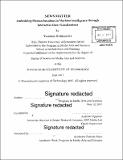News Matter : embedding human intuition in machine intelligence through interactive data visualizations
Author(s)
Rubinovitz, Yasmine
DownloadFull printable version (10.77Mb)
Alternative title
Embedding human intuition in machine intelligence through interactive data visualizations
Other Contributors
Program in Media Arts and Sciences (Massachusetts Institute of Technology)
Advisor
Andrew Lippman.
Terms of use
Metadata
Show full item recordAbstract
In this era of luxurious information, we are free to access as many news stories as we want. However, news is so abundant that people don't have the time to consume all of it, nor the time to select which stories they want to know about. We trust editors and algorithms to decide for us, giving away our control and sometimes missing the big picture. For computers, news stories are usually not annotated or categorized, they come in as an unstructured text that for machines is hard to generalize. While numerous tools exist that use Natural Language Processing to identify features of news articles, few use NLP to help readers navigate the universe of news stories. This thesis proposes a novel interaction method, coupling principles of data visualization and user experience with an interactive machine learning approach to ease our understanding and exploration of mass information while collecting nuanced annotations for the same information. We present a human machine collaboration where the computer analyzes and renders the data, making it easier for the reader to explore. The user in turn gives annotated labels that help the computer better analyze the next data points. As a proof of concept, we present Panorama, an interface for open, transparent and collaborative exploration of news. Panorama addresses information overload, by allowing users to filter, organize and control their news feed. Panorama is also an interactive machine learning system. As the user reads and explores the news that were analyzed by machine learning models, she is encouraged to submit feedback that is sent back to these underlying models, helping them improve. This work explores the relationship between knowledge and design. It demonstrates how data visualization and interfaces help humans understand, build, control and improve a system based on machine intelligence.
Description
Thesis: S.M., Massachusetts Institute of Technology, School of Architecture and Planning, Program in Media Arts and Sciences, 2017. Cataloged from PDF version of thesis. Includes bibliographical references (pages 87-92).
Date issued
2017Department
Program in Media Arts and Sciences (Massachusetts Institute of Technology)Publisher
Massachusetts Institute of Technology
Keywords
Program in Media Arts and Sciences ()